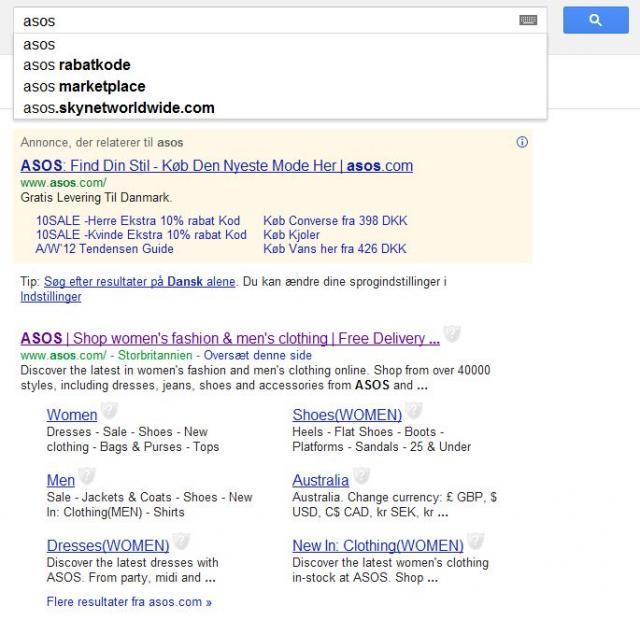On Tuesday, Google announced that it was rolling out city-level targeting and location extensions for nine new countries within AdWords, thus bringing the full list of countries with these geo-targeting options up to 43. Coincidentally, Google made a switch to Nielsen DMAs for US metro areas and released postal code targeting for Canada, allowing marketers to more easily coordinate, integrate and benchmark traditional and digital performances.
PPC advertising can support your organic geo-targeting efforts in many ways, such as gaining valuable insights into local search behaviour to help shape your organic keyword list for the local market. But even if you have not got the resources necessary to fully localise your business presence in the different countries you serve, PPC can make you appear much more local than you really are. For example, when searching for online fashion retailer ASOS on google.dk from a Danish IP address, this is what I get:
The ad copy is in Danish and prices are listed in local Kroner currency, although ASOS does not serve up a local version of its website targeted specifically at Danish consumers. While this approach does not nearly match a fully localised online presence, it somehow compensates.
Again, like in almost any other area, geo-targeting best practices will vary based on the specific business case scenario. With this in mind, Google AdWords offers different geo-targeting options to suit the varying needs of advertisers.
Target by country
If you, like ASOS, have no physical presence in the country but ship to all areas within that country, targeting your ads by country will generally be the way to go.
Target areas within a country
If your area of service is limited to certain regions or cities, you would want to narrow down your geographic targeting specifications to ensure that your ad only displays to searchers in those particular areas. Also, even if servicing an entire country, you may decide to run a special promotion targeted only at people in, say, Berlin. Similarly, you may decide to run that same promotional campaign in 10 select German and French cities. Doing so allows you to benchmark ad performance on a city-level within a single country, as well as between countries.
Target a radius
As mentioned in the AdWords Helpcenter, “radius targeting helps you identify an area around your business to target, rather than specifying individual cities, regions, or countries.” This basically means further narrowing down your targeting criteria by specifying a proximity limit. This can be useful for local businesses that largely depend on footfall traffic. Also, you might have multiple physical locations (e.g. Starbucks), and may want to promote those separately according to the proximity of the searcher.
Include location extensions and insertion (if your business has a brick-and-mortar location)
The radius targeting option serves a purpose quite similar to a Google+ Local page. However, tough competition for the local keywords you want to rank for could apply, or you may not even be eligible for a listing in Google+ Local (Places was easier to refer to, but someone once said to call each thing by its right name, so I better do that).
By including a location extension to your ad copy (if available in the country you are targeting – see Google’s full list here), your nearest location and phone number will show along the ad text, thereby increasing the likelihood of a customer actually getting in contact with you.
Now, should you be worried about having to create a ridiculous amount of ad copy with all your different locations, do not be. Location insertion allows you to dynamically update the ad text based on the searchers geographic location, making it easy for businesses to target multiple locations without sacrificing relevance.
Geo-targeting is a crucial means of improving ROI, and while locally relevant PPC ads can be a great tool in the overall localisation strategy, it should not be the only one.
Any experience with geo-targeting management? Take this survey and receive a free report on the impact and challenges of geo-targeting globally.
Immanuel Simonsen
Latest posts by Immanuel Simonsen (see all)
- Is Baidu losing its crown in China? - July 31, 2015
- Global logistics brand DHL eyes Chinese e-commerce growth - July 27, 2015
- VKontakte To Launch Rival To Instagram - July 21, 2015





